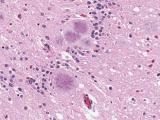May 7, 2004 (CIDRAP News) Federal and state disease investigators have rejected a theory that a cluster of 17 suspected Creutzfeldt-Jakob disease (CJD) cases were linked to restaurants at Garden State Racetrack in Cherry Hill, N.J.
Concern had been raised that 17 deaths might have resulted from eating meat contaminated with the agent of bovine spongiform encephalopathy (BSE), or mad cow disease, at racetrack restaurants between 1988 and 1992, according to a report by the Centers for Disease Control and Prevention (CDC). Eating BSE-contaminated meat products is believed to be the cause of variant CJD (vCJD).
The CDC and New Jersey health officials investigated the 17 deaths and determined that 11 of them were due to definite or probable CJD, according to the CDC report. However, there is no evidence that any of the cases were vCJD, and they were not linked to any common source of infection, says the early-release report in Morbidity and Mortality Weekly Report.
Analysis of brain tissue specimens pointed to classic CJD and not to vCJD in five of the cases, the CDC says. In six other cases, brain tissue specimens were unavailable, but clinical and diagnostic evidence indicated probable CJD. Of the six remaining cases, three were found to be unrelated to either CJD or vCJD, and three remain under investigation, the report states.
The 14 deaths that were definitely or possibly linked to CJD occurred over about 9.25 years, the report states. Attendance at the racetrack from 1998 through 1992 totaled about 4.1 million, and the overall incidence of CJD in people aged 50 and older is 3.4 cases per million per year. Given these facts, 14 CJD deaths among racetrack attendees in 9.25 years "would not be considered unusual," the CDC says.
The report stresses that classic CJD and vCJD are different diseases, with different clinical and neuropathologic characteristics and a different genetic profile. "Thus cases of vCJD can be distinguished from classic CJD on the basis of clinical and pathologic data," and no evidence indicated vCJD in any of the cases, the article says.
In addition, investigators identified the CJD subtypes in four cases and found they were all different, suggesting that the cases did not have a common cause.
CDC. Creutzfeldt-Jakob disease not related to a common venueNew Jersey, 1995-2004. MMWR 2004;53(early release) [Full text]


















